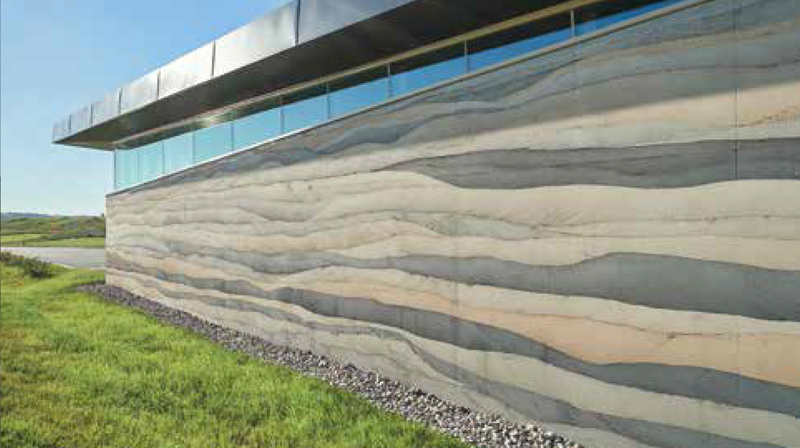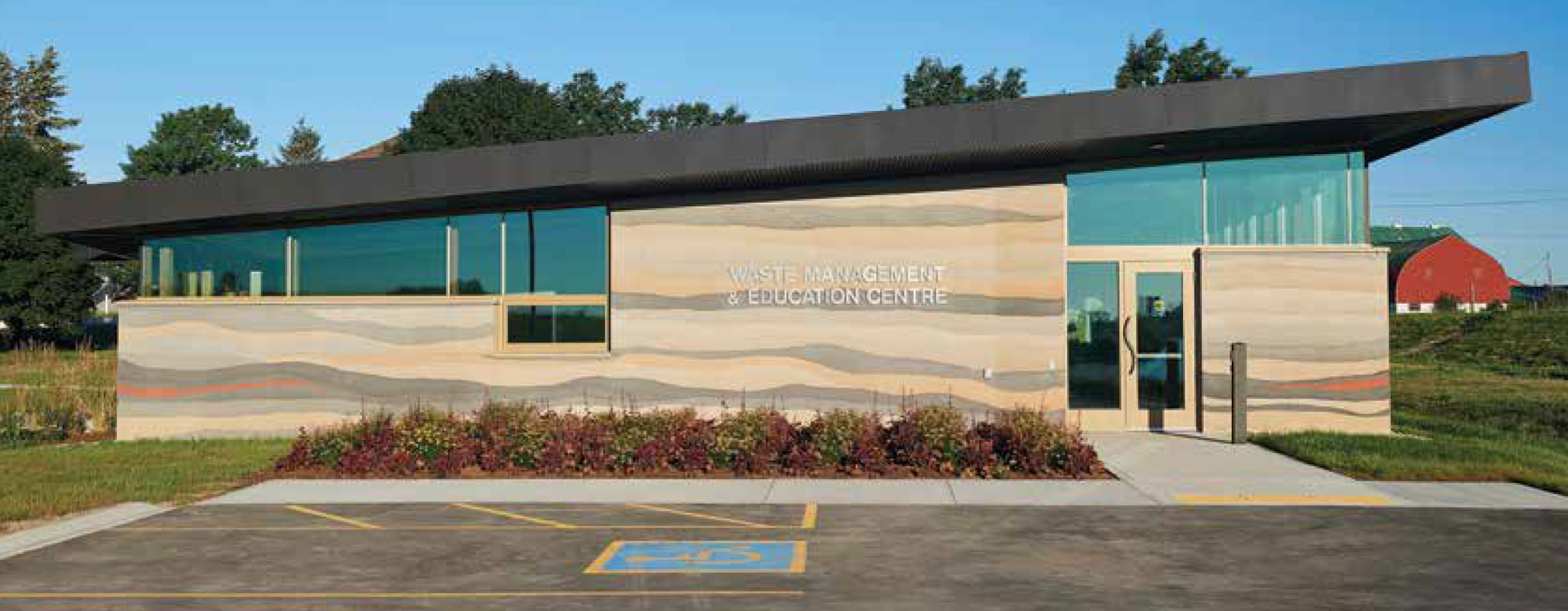Net zero rammed earth building a public resource

In 2015, the County of Oxford established two key strategic goals of becoming a Zero Waste community by the year 2025, and a 100% Renewable Energy community by the year 2050.
The new building for the Oxford County Waste Management Facility replaces the original administrative office, and now also includes a regional conference room and displays about waste management and conservation for public education and school field trips.
The project energy goals include the provision of a comfortable building that consumes very low amounts of energy during operation by implementing strategies and technologies of typical Passive House projects.
The Net Zero project program and budget allowed the energy needs for both the new building and all existing site buildings and facilities to be met by a ground-mounted solar photovoltaic array situated along the access driveway in public view.
BUILDING STATISTICS
GFA: 372 sq. m.
R-values: under floor 24, walls and roof 55, windows 9.
HVAC: electric 2 air to air heat pumps, with ERVs – under floor supply air.
Site: Net Zero PV size of 120kWAC, with 24kWAC being required to Net-Zero the administration building only.
PROJECT PERFORMANCE
Energy intensity (building and process energy) = 60.7 KWhr/m2/year
Energy intensity reduction relative to reference building under 2015 NECB = 35%
PROJECT CREDITS
Owner: Oxford County
Architect: Michael A. Wilson Architect
General Contractor: Gateman Milloy Electrical and Mechanical
Engineer: MNE Engineering Inc
Structural Engineer: MTE Consultants
Commissioning Agent: Zon Engineering
Energy and PV Consultant: Zon Engineering Energy
Modelling: Hadlock Consulting
Photos: Mark Burnham
The compact, nearly square building volume reduces wall surface area and admits natural light from all sides through a clearstory for privacy in the locker room on the east and north, and operable windows at the south and west. The white ceilings and interior demising walls reflect the natural light sufficiently to negate the need of the energy-efficient lighting systems for much of the time.
Though still uncommon in Ontario, rammed earth construction, also known as “site-placed concrete”, was proposed to the owner early in the design process as an appropriate system for a building on a landfill site. Its method of construction, in which the walls are formed as pigmented layers in compacted lifts, make a reference to the layered nature of a landfill site.
The rammed earth wall consists of an interior loadbearing wythe of 200 mm, a 200 mm layer of insulation, and an external wythe of 150 mm. Though the minimum design bearing capacity required was 10MPA, with the high lime content of the vernacular granular used, 24MPA was achieved at 28 days. The thermal mass of the walls keeps the interior humidity and temperature extremely consistent and comfortable.
The painted triple-pane wood windows are made from the resilient Accoya® wood and are protected by the roof overhang which also reduces solar gain. The gentle slope of the roof is adequate to prevent ponding to extend the life of the roof membrane.
The building performance will be measured against the New Building Institute’s (NBI) Zero Net Energy criteria (71.5 kWh/m2) with a goal of demonstrating that the building achieves Net-Zero performance over a 12-month period. If the building meets this target it will be one of the first buildings in the country to be verified as a Zero Net Energy building by the NBI.
Educating the public is as important a function of the building as providing new space for administration and operations staff. Outfitted with interactive educational displays about recycling materials, energy reduction methods and landfill technology, the building is a destination for school children.
Broken glass and even some of the architect’s personal fossil collection have been visibly placed within the polished concrete floor, and a reclaimed barn beam in the feature wall display promotes the idea of repurposing building materials. Real time energy consumption displayed on a computer monitor within the main room of the education centre shows visitors the peak energy consumption periods during the day.




